| |
In fact, its fascination with the pleasure of images and the dangers of looking have invited comparisons with Michael Powell's Peeping Tom (1960) – a very apt point of comparison indeed. |
| |
|
To the casual moviegoer, Manhunter is ostensibly noteworthy for Brian Cox's interpretation of serial killer and cannibalistic gourmet Hannibal Lecktor (that's the spelling they use in the end credits). His performance, our first glimpse of the now overly feted monster, was – from this Manhunter aficionado's point of view – one of those "Where were you when..." moments. In the 80s, I spent a lot of time with fellow film critics, some of whom became good friends. I've been summoned twice to admire a particular actor's craft and excitedly travelled quite a distance to share them with wide-eyed, like minded souls. The first was William Hurt's extraordinary turn in The Janitor (aka Eyewitness about which my friend just remarked with shock that "He is a janitor!") and the second, Cox. His character is now well known and (dis)tastefully folded into pop culture in a way most serial killers are not and probably should not be. Anthony Hopkins, an actor I admire enormously, added a small percent of theatricality to his three outings in Lecter's (literary spelling) stylish and subsequently unaffordable Italian shoes. He got broader (and had more fun) as the sequels progressed but it was Cox's extraordinary turn as the wicked doctor that made the first and greatest impression. It almost struck me as the most ridiculous conceit, after reading the first Lecter novel, that a cannibal character would be named Hannibal – think about that for a moment, a tabloid journalist's blood-wet dream. It's like presenting a killer called Miller (who uses weapons such as a hand held Black and Decker and the steering column of a boat). Author Thomas Harris' character not only ate his way off the page but planted himself at the pantheon of on-page and on-screen villains. Add a liver and some Fava beans and hey, we have a new bogey man (a nose is not a sweetmeat so we don't have to go there...) Recent literary and cinematic incarnations have only served to dilute the mystery of the character but in Manhunter, we see him whole and we're startled, his contradictions, horror and allure fresh and intact.
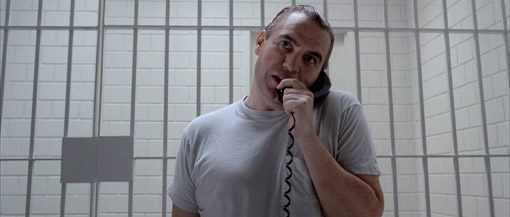
Here was a master class in understatement from an actor while playing one of the most outrageously egregious killers in crime fiction. It doesn't surprise me that Michael Mann's reaction was "Wow!" at the audition tape. I will not attempt to unlock the secrets of this un-showy but malevolently contained performance but of course the script helps. Lecktor's first scene contains so many quotable lines given enormous weight by Cox, you forget these two men are discussing the murders of entire families. It almost feels like two average Joes sharing baseball statistics. Cox's contribution in a movie just shy of two hours is mere seconds over nine minutes... But I will share one small snippet of personal experience. I was lucky enough to hire Cox to provide a voiceover for a film I was editing in the early 90s. And the great aspect of hiring VO artists is that you can often meet your screen heroes who are all up for earning a few grand for a morning's reading (that was decades ago... Replace 'a few' with 'many' these days). He was charming and required only the odd flapjack to keep those lovely rounded Scottish vowels going. I still remember vividly Bob (TV's Edge Of Darkness) Peck's ever-rumbling stomach, a tiny disadvantage when it comes to securing a clean recording.
But Cox is simply one element in a wonderfully engaging crime drama based on the book Red Dragon by Thomas Harris. This was the movie and book that introduced us to the good guys who had to think like the bad guys to succeed. Profiling started to get a wider public understanding and if Lecter and his ilk reached a pop art zenith, it must have been the 1991 clean Oscar sweep by Silence of the Lambs (the first police procedural winner since 1967's In The Heat Of The Night). But Michael Mann's Manhunter got there first and despite the movie suffering from poor distribution (it took a full year to reach the UK) and failing to make back its budget theatrically, it's still a startling work with a number of superbly atmospheric sequences and a few stunning performances from some marvellous actors. Former detective Will Graham is retired after suffering from a violent encounter with a certain Doctor Lecktor. His ex-boss needs him back on the team because there's a serial killer who's carving up entire families on a lunar cycle, a literal family butcher. Will seeks help from the imprisoned Doctor Lecktor ("to recover the mindset...") and gets deeply involved in the desperate hunt for the 'Tooth Fairy'...
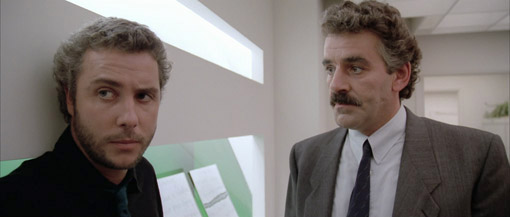
But unusually for this genre, director Mann is not content to leave his primary killer's humanity at the door. The 'Tooth Fairy' is given a great deal of screen time so that while we certainly can't condone his actions, we get to sympathise with him enough for it to matter. That's enough plot because you don't need to know much more. The script is whip-smart with real revelations of inspired detective accomplishment as Will Graham climbs inside the mind of a demon of a man and figures out directions to turn. It takes some skill as an actor to make talking to yourself seem natural and unforced. Playing Will Graham with grim determination is possibly the small screen's most famous forensic detective, Gil Grissom. Manhunter went some way to usher in all the CSIs of the world and even the character names are eerily similar. William Peterson is terrific in the role. He has to be, in turns, a Holmesian expert in deduction, a devoted but anxious father and husband, a recovering psychotic and an action hero. That's quite a juggling act.
If Brian Cox made the initial big impression, Tom Noonan (with perhaps the more featured role) is no second-rater. Noonan is utterly convincing as the evolving, family killing, serial murderer, Francis Dollarhyde. A giant of a man with severely curtailed social skills and a malformed harelip (an apparently common physical abnormality in deeply troubled individuals), Dollarhyde finds love with a blind colleague that leads to the film's stand out sequence. That's a very personal opinion of course but I can't recall too many sequences in movies where the music and images are so right it's hard to imagine one without the other. I have just watched it for the umpteenth time and stand amazed (twenty-five years on) at its emotional power and cinematic surefootedness. I will just say one word. Tiger. Wow. OK, two words. Let's nod at the track used here (Coelocanth by Shriekback) as music provides a significant percentage of the emotional punch. Noonan's Dollarhyde is simultaneously repellent and pathetic (in the true 'invoking sympathy' sense). Noonan's own thespianic isolation during the shoot could be seen as the pretentious trappings of an actor's method but like Daniel Day Lewis's defence of his own working practices, whatever works. And Noonan is profoundly mesmeric, his physicality both awkward and supremely graceful, a walking ambivalence of a creature who finds love by chance and lets it slip away as the monster awakes (his 'becoming') almost in a petulant, childlike fashion. The small bits of business he employs, arcing hand movements, delicate caresses of a kidnap victim and his social awkwardness stay in the mind long after the performance has curtained out. In fact, his big reveal is a constant joy due to the timing and delivery of three words, a scene Slarek and I are always quoting to each other. "Here I... Am." Shudder time. You owe him awe...
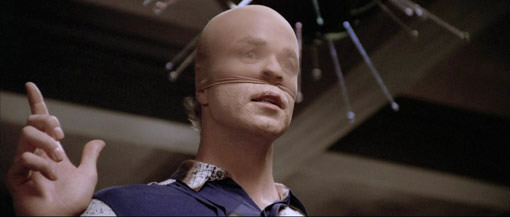
Dollarhyde's brief romance with Reba is an astonishing development in a film about the hunt for a serial killer. Reba (Joan Allen) should be a familiar face to fans of the Bourne sequels (she's Pamela Landy, Jason's only friend in the world). She plays blind convincingly and sympathetically and the relationship she instigates with Dollarhyde is brief but so heartfelt. What I adored about this relationship was that the female ('handicapped' by blindness) defiantly plays the active not passive role. She is not seduced by Dollarhyde; he is definitely seduced by her. There are too many instances on both small and big screens of handicapped characters being reduced to passive victims by dint of their own specific inability. It is, put bluntly, a pile of horse manure that people's emotional and physical needs are reduced or nullified by their specific handicaps. I'm reminded of an extraordinary moment in an otherwise bland but enormously popular soap opera of the 70s. Forgive the odd diversion but it's relevant.
Crossroads was a beloved daily serial that was famous for its appallingly low productions values. The titular motel owner's son, Sandy (incidentally the first paraplegic character on British TV) was going to marry. Forgive the lack of detail as I neither remember nor care who he was going to marry but I do recall him forcibly kissing his intended who recoiled with shock. She was revealed in that instant as being a woman who desired no sexual contact with a man she thought incapable of foisting himself on her – a rather profound reversal of the usual physical strength paradigm we're used to. It was a tremendously exciting development – here was a handicapped man asserting his sexuality. Why was it that disabled people were rarely granted any kind of a sexual identity in television and film? Could it have been fear and the need to re-think what sexuality actually is beyond the so-called norm of two fit Olympians tromboning for their countries? As the inimitable Alan Bennet said to an infatuated John Fortune, "...you put it in and jiggle it about a bit..." Cinematic sex and its own brand of seduction are turned on their male-centric heads in one glorious scene of sexual predation. In Manhunter, Reba goes after Dollarhyde with a refreshing determination even though she can't see who (and what kind of a man) she's advancing towards. It's wonderful, yes but it's also right. The scene of the morning after shows a tenderness in Dollarhyde that no two dimensional serial killer could ever pull off. And also in this scene the light sings to us exquisitely. I like this movie a lot. Can you tell?
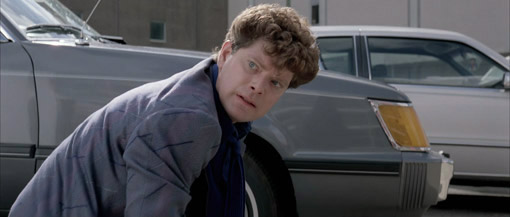
A few small notable asides before I urge you to go after this disc with gusto... The one real surprise this time around is suddenly realising who is playing the oleaginous and sleazy reporter Freddie Lounds. Take a bow Stephen Lang, he of the ridiculously overblown physique and scarred bonce from Avatar. Yes, the military bastard... that's Freddie Lounds. I would never have made that connection, so comfortably nestled in my memory is Manhunter. Unnoticed before is a startling jump cut (a cut within a shot or scene that is discontinuous. At 16 mins and 49 secs, a small part of a shot of Will at the TV has been removed resulting in a small but noticeable jump. Film-makers (and editors) usually stay well clear of these sorts of cuts unless there's a specific point to be made. One final nod (with an unbidden Slarekian prompt) to the title. 'Manhunter' is the default commercial title. OK, we can live with that. But the font for the front title? You almost expect a 'Kapow!' super'ed over any fight scene. I'd like to think it was an 80s thing. But perhaps Michael Mann woke up cranky one morning and said "Yes," to a neophyte graphic designer who thought that all his Christmases had come at once. It's not a great title and it's a terrible typeface. But if those are all the negative things I have to say, we're on to a winner.
Don't look at shot one and make any judgements. The first few shots (presumably the killer's VHS coverage of his pre-carnage trip upstairs) are deliberately graded down in quality. It's the shots on the beach shortly after that you can point at and sigh with a deep satisfaction, "Mmmm, High Definition." My eye darted around the frame just taking in the new level of detail, just delicious. With such a perfect first scene (exposure, colours, framing) taking advantage of the HD from a 35mm negative master, it's true the images don't zing as much when we are in darkness but to see a beloved film in this spotless and detailed quality is still intoxicating. Contrast is solid with some blacks in the darker scenes wavering towards the darkest grey and the colour palette is rendered vividly (this was Michael Mann and Dante Spinotti in the 80s, colour mattered). A solid nine out of ten for the image quality.
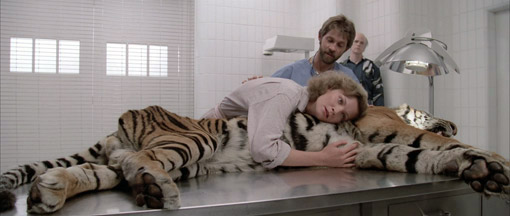
In the Set Up menu, there are three choices; 5.1 DTS HD Master Audio, 2.0 LPCM Stereo and English Subtitles. The 5.1 track is unfussy and the rear speakers rarely used for anything but atmosphere. The music sets off the sub a few times but the mix is un-showy and clear, a good combination. The Stereo mix is also a no nonsense dialogue clear affair delivering a solid accompaniment to a terrific movie.
Trailer (2' 05")
A standard SD 80s trailer with a sparse gravelly voice intoning Will Graham's tasks. It sells the film well enough (with a lovely cut from smashed glass to rain outside a window) but it is a product of its time. Manhunter is still a naff title and its garish green comic book font is still in place – but if you're selling a serial killer movie, Red Dragon won't cut it however perfect a title it is for the novel...
Inside Manhunter (17' 23")
The accompanying 'making-of' is more a celebration of the actor's craft. Michael Mann is noticeably absent but shoring up the film's reputation are both Cox and Noonan as the bad guys and their counterparts, Peterson and Allen reminiscing fondly about the feature. Entertaining and anecdotal, it's a decent if short extra feature.
The Manhunter Look – A Conversation with Dante Spinotti (10' 11")
A genial chat with the man responsible for the movie's stylised look. It was his first Hollywood movie. Talk about making an impression.
Director's Cut (Theatrical Feature with an added 3 mins)
The details of what's out, what's in and what's new are listed in amazingly considered detail below – please follow this link where the comparison work has been done for me. Thank you, movie-censorship.com.
http://www.schnittberichte.com/report.php?ID=1299
How crushingly disappointing! To hear Mann's commentary, you have to play the entire Director's Cut in standard and in some cases significantly sub-standard definition (pah!). The so-called 'Director's Cut' has probably not run its course as a marketing ploy to lure in the feckless and those ignorant of the film making process. The original elements of (presumably) Mann's first cut of the movie are shoehorned in as if from a poor quality tape master. Worse than that, the poor quality shots sometimes replace their sparkling Blu-ray counterparts (if you're not playing the commentary). Having been a fan for twenty-five years, I'm not immune to the lure of the 'Director's Cut' but as Slarek has already argued, it's now more of a marketing strategy than a celebration of the powerless artist raging against the corporate machine trying to get his or her art out into the world the way they intended. But then Michael Mann himself has something to say on the matter... In the commentary, he states that it was his original cut that made it to theatres and that he had a chance to 'remake' the film after so many years of distance. Not entirely sure I think this is a good cinematic custom. The principal practitioner of this dubious tweaking of cherished works is, of course, George Lucas. He's not the best commercial of an artist raging against the machine.
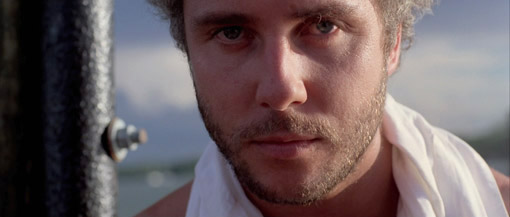
Yes, it is a small electric thrill to see the un-aged actors in their famous roles suddenly saying lines you've never heard before in scenes you've never seen but of all the fuss, does this cut really improve upon the theatrical version? There is one shot I might have retained to fully understand Graham and Lecktor's relationship – his enormous scar on a bare torso seen reflected in a window. But this aside, there was a strong sense of (I think the term is...) 'meh' about this cut, a take it or leave it stance. I'm wedded to the original cut and it's hard for a third party to make a dent in that relationship.
Commentary on the Director's Cut by Michael Mann
I'm assuming the commentary is ported from Anchor Bay's earlier two disc release. At first Mann starts off with information any Manhunter fan has already in their veins. He really doesn't have to tell us what novel the movie is based on but I guess if you have a microphone in front of you, the onus is to say something. These are a smattering of some of the gems once Mann got into his stride...
He was aware of the power of Cox's Lecktor and chose to keep his appearances sparse. Brian Dennehy wanted to play the cannibalistic gourmet but in the end, the burly actor selflessly suggested Cox after seeing him on stage. His work was stunningly threatening. "You know it when you see it..." The scenes on an airplane were shot on a commercial flight much to the consternation of flight and cabin crew. Can you imagine that happening today? There is Mann's give away that his "Director's Cut" is a rethink in hindsight, not a reinstatement of a previous beloved version. He mentions that the extra-terrestrial landscapes in Dollarhyde's house are some of production designer Mel Bourne's best work. There were 50 to 60 actors for the part of Dollarhyde and after the fourth line of the read – Noonan nailed it. Apparently the crew repeated two lines over and over to relieve stress on a difficult shoot. They were, unsurprisingly "Save yourself, kill them all" and "You're so sly, but so am I!" 'Billy' (William Peterson) was not stale in multi-takes – "You've seen these films!" And finally, and surprisingly, the action packed finale was shot in three and a half hours as the sun was rising.
Manhunter is a terrific, intelligent and highly stylised police thriller with some top-notch performances that mark this as a must-have disc. Let's add to that a Hannibal Lecktor very few have seen and appreciated (compared to the exposure and performances of Cox's fellow Celt, Anthony Hopkins), and Michael Mann's authorial flourishes. Forget and dismiss the lazy criticisms of the so-called 80's out-dated style. Just enjoy the thrilling ride. And remember, it's all about seeing...
|